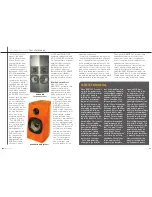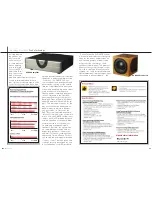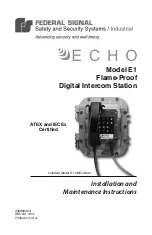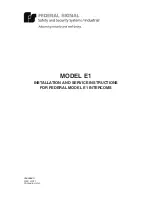
Now let’s fast-for-
ward to the 2006
CEDIA show, where
Phase Technology
announced the new
DARTS 525 system,
which in 5.1-channel
configuration sells for
between $11,000 and
$12,800 (depending
upon whether you want
one sub or two). The
system price buys you
5.1-channel’s worth of
speakers plus a power-
ful DSP-controlled, 16-
channel Class D ampli-
fier. Sixteen channels
are needed because
the DARTS 525 system
powers each individual
speaker drive unit
(or set of drive units)
with its own ampli-
fier channel. Don’t
be fooled by the tiny
525 main speakers,
though, because
there is nothing
miniature about this
system’s sound.
The DARTS 525
system consists of
two 2-way biampli-
fied DFS-525LR
main speakers, a
3-way triamplified
DFS-525C cen-
ter channel, two
bipolar/dipolar
biamplified DCB-
SURR surround
speakers, a pair
of 500-watt DCB-112S
powered subwoofers, and
a DP-2000 DSP-controlled
16-channel Class D power
amplifier that cranks out
250Wpc. We describe
the distinctive technolo-
gies and set-up proce-
dures used for the DARTS
system in two sidebars,
but for now let’s focus on
how the system performs.
Clarity Comes First
Right off the bat the
DARTS 525 system bowls
listeners over with its
stunning openness and
transparency. With many
AVRs and some A/V con-
trollers, I’m used to hear-
ing a certain amount
of low-level hash with
DSP circuits, but in
the DSP-controlled
DARTS 525 system I
really couldn’t hear any
hash or graininess at all.
What I heard, instead,
was a veritable smor-
gasbord of sonic details
and textures spread out
as if on a banquet table.
With the DARTS 525 rig
you’ll want to put on fa-
vorite music recordings
and movies one after
another, just to see if
the system will reveal
any cool new pieces
of low-level informa-
tion you might have
missed before. It’s an
addicting experience.
On movie soundtracks in particular,
I heard low-level details that often get
lost or buried in other systems. One
good example would be the shootout
scene from
Open Range
, which enthu-
siasts know for its violent action—and
many sonic subtleties. As Charlie and
Boss face down their opponents, for
example, you can hear insects chirp-
ing and the prairie wind whistling faintly
and mournfully in the background.
Through the DARTS 525 system these
subtle details become crystal clear
and serve—on an almost subliminal
level—to remind us how terribly alone
and exposed the cowboys are.
But beyond finesse, the system also
serves up explosive dynamics that
seem impossibly powerful given how
small the DARTS speaker modules are.
The “Omaha Beach” scene from
Saving
Private Ryan
convinced me the system
could at once play loudly and cleanly,
technology focus focus:
Phase Technology
DFS-525LR main speaker
DCB-SURR
surround speaker
When DARTS 525 systems
are sold, the dealer sends
a DARTS-qualified installer
to the user’s home to
calibrate the system (the
dealer may or may not
charge for this service).
The installer brings a cali-
bration system consisting
of a laptop equipped with
test/calibration software,
a calibrated microphone,
and a special “umbilical”
cord that connects the lap-
top to the DARTS 525 sys-
tem amplifier. The installer
runs a series of laptop-
driven tests (pulsed sweep
tones that are played
through each speaker
in succession), taking
multiple measurements
from locations in and near
every seat in the room.
Once data gathering
is complete, the installer
runs a computation-inten-
sive, Audyssey Laborato-
ries-developed computer
program that calculates
frequency and time re-
sponse correction filters
for each speaker in the
system. Phase Technology
offers users four possible
EQ tuning curves to allow
for rooms that are large or
small and whose acous-
tics may be reverberant
or dead. For reverberant
spaces, the system rolls
off upper midrange and
treble response a bit to
compensate for the fact
that “live” rooms tend to
make speakers sound
overly bright. Once a
preferred EQ tuning curve
is selected, the installer
downloads filter settings
to the amplifier’s DSP
engines via a faceplate-
mounted USB port.
As the last step in the
set-up process, the in-
staller disconnects the
calibration system and
configures the system’s
preamp/multichannel con-
troller to drive the DARTS
525 amplifier. During the
data analysis process,
DARTS calibration software
calculates recommended
speaker distance settings
(accurate to with a tenth
of a foot) and channel
level settings (accurate to
with a tenth of a dB). The
installer then connects the
controller to the DARTS
amplifier and loads the
recommended settings,
at which point the system
is ready to play music or
movie soundtracks in a
way most people have
not experienced before.
DARTS 525 System Setup
TPV
|
March 2007
43





















